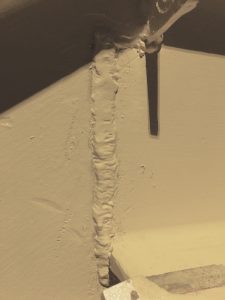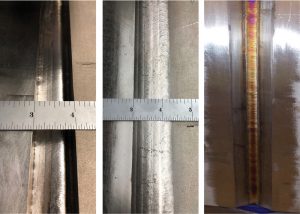A Rigorous QMS, Human Performance Attributes, and Training
Weld quality is the bedrock of structural welding execution as described in American Iron and Steel Institute (AISI) specifications, and American Welding Society (AWS) Codes D1.1, D1.2, and D1.6. The term “quality” represents “conformance to a specification” where the term “specification” refers to the requirements of a code, drawing, or contract. Weld quality is not inspected into a structure or weldment but is the result of production process improvements. Businesses engaged in seismic structural fabrication, American Society of Mechanical Engineer (ASME) Section III nuclear component fabrication, or ASME Section VIII pressure vessel fabrication, understand this philosophy. Engineering endeavors exist where weld failure is not an option without placing undue risk on human life, the environment, or property. Quality of welding workmanship is not a catchphrase. Substandard weld quality cost lives. Also, it represents waste as the result of liability lawsuits, warranty repair or replacement costs, and lost revenue due to expensive rework or repairs (Figure 1). Quality welding is a critical component in the fabrication of safe, dependable, and trustworthy structures. This article focuses on achieving quality structural welding and fabrication.
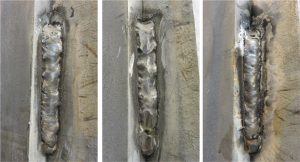
Figure 1. AWS Code D1.1 structural steel welds on galvanized steel – galvanized coating was not removed prior to welding. Numerous welds were rejected due to unacceptable profiles and poor workmanship.
Quality Management System
Quality does not come from inspections alone, but in conjunction with production process control improvements. A Quality Management System (QMS) focuses on the welding process as opposed to after-the-fact inspections. Employing process controls is the method by which weld quality is built into a structure. Monitoring and controlling process parameters, qualifying welding procedures, calibrating equipment, training, inspections, and maintaining records are all part of the process controls regimen.
Weld inspections remain a vital and necessary quality component. However, inspections alone cannot be depended upon to improve weld quality. Whether on a construction job site, in a manufacturing facility, or in a fabrication job shop, the utilization of process controls and nondestructive testing (NDT) methods are crucial parts of an overall QMS. Within a QMS, process validation is required where processes need to be validated before production via a test resulting in a Procedure Qualification Record (PQR). Also, appropriate training needs to be provided for welders and all other personnel engaged in activities that affect weld quality. Welders are directly engaged in the “arcs and sparks” and have the most significant impact on weld quality. If visual weld discontinuities occur during welding, welders bear the responsibility to stop and seek support in determining the root cause as opposed to continuing to weld (Figure 2). To achieve First Time Quality structural welds, control production costs, fabricate safe and reliable structures, employ a well-executed QMS, and continuously maintain welders’ training and qualifications.
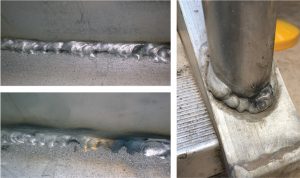
Figure 2. AWS Code D1.2 structural aluminum welds. Welds were rejected due to unacceptable profiles, overlap, and poor workmanship.
Quality Welding and Inspection
Weld inspection remains a vital and necessary component of a QMS. The role of AWS Senior Certified Welding Inspectors (SCWI), Certified Welding Inspectors (CWI), and American Society for Nondestructive Testing (ASNT) Level II/III inspectors is to perform weld inspections to determine if the weld meets acceptance criteria of the applicable code, specification, or drawing. Weld inspection is a serious responsibility for all inspectors. For example, although the principal function of AWS SCWIs and CWIs is to perform visual weld inspections, inspectors also review test results of inspections performed by ASNT Level II/III inspection crews. In addition, SCWIs and CWIs review welder qualification test records, welding procedure specifications (WPS), weld maps, drawings, etc., as well as being engaged in maintaining inspection documentation, performing fit-up inspections, verifying weld filler metals, or observing post-weld heat treatment (PWHT).
For a given project, a customer’s weld specification may supersede an industry welding code by specifying more restrictive weld acceptance criteria (e.g., weld toe fatigue blending criteria, beam coping criteria, or workmanship quality). The customer or general contractor sets the tone of a project by conducting pre-project briefings that detail acceptable workmanship quality expectations using photographs, representative work examples, illustrations, and more. The goal of pre-project briefings is to “calibrate” welders, inspectors, quality assurance engineers, and supervisors so pertinent personnel understand the level of welding workmanship quality expected. The customer is the “Final Inspector.” Hence, it is essential to set the quality standard and establish expectations before project welding, noting that mediocre or marginal quality of welding workmanship will not be acceptable (Figures 3 and 4).
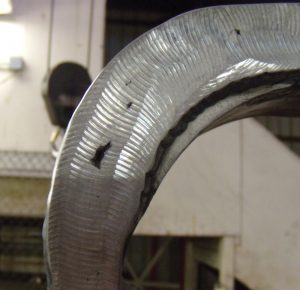
Figure 4. Machined groove weld on an AWS Code D1.2 structural aluminum weldment. The weld was rejected due to cracking and voids.
Quality of Welding Workmanship
The following are key human performance attributes that are contributing factors in achieving premium welding workmanship quality. Ultimately for businesses, the core values and the prevailing paradigm is such that craftsmanship represents a culture, as behavior and a way of thinking.
- Attitude: Taking pride in one’s personal performance. Being self-motivated to provide solutions to tasks.
- Accountability: Taking ownership of work/performance. Producing and delivering a superior product because the work reflects you.
- Workmanship: Employing skill/proficiency with which a task is performed – applying garnered experience. Having zero tolerance for rework and repairs due to poor work practices.
- Teamwork: Collaborating with others to improve project performance. Encouraging an environment of inclusion and constructive brainstorming to improve the overall work plan.
- Knowledge and Training: Seeking opportunities to train and mentor others in the area(s) of your expertise. Seeking self-development via continuous education and training to become an expert.
- Professionalism and Integrity: Being honest and trustworthy and doing what is right in the absence of oversight. Wanting to do top-of-the-line work the right way, the first time, or not at all (Figure 5).
Avenues for Welder Training
There is no substitution for a welder’s proficiency skills and training. Proficiency skills are developed and perfected through practice. Some companies have established training centers to provide hands-on and classroom instruction so that welders can practice and acquire essential skills and knowledge required to work in fabrication departments. Comprehensive welding schools such as the Lincoln Electric Welding School, the Hobart Institute of Welding Technology, and the Tulsa Welding School are well-recognized schools where welders learn proficiency skills and knowledge. Also, various other private/public vocational and technical schools are available for welding personnel to attend. Welding schools provide hands-on, practical training coupled with classroom instruction where welders can learn the fundamentals of welding as well as associated practices. The AWS Certified Welder Program provides welders with experience using welding procedures employed in structural steel, pipeline, sheet metal, and chemical refinery applications.
Furthermore, AWS offers online courses related to the science, equipment, process variables, consumables, safety precautions, and the advantages and disadvantages of individual welding processes. Online courses are becoming increasingly prevalent in terms of providing access to welding or fabrication instruction. The U.S. military has welding schools, and there are veteran welding training programs accessible by way of companies, organizations, and unions. Select unions, such as the Ironworkers, Boilermakers, and the Pipefitters unions, offer apprenticeship programs that combine classroom instruction with on-the-job training. Regardless of the type of hands-on training, classroom instruction, and teaching received, knowledge is accumulative and never wasted.
The House of Weld Quality
The House of Weld Quality (Figure 6) symbolizes philosophies, principles, and actions essential to quality structural welding and fabrication. The objective is to uphold the structural integrity of the House by not compromising weld quality. The House is constructed on the Foundation of Weld Quality, a QMS such as ISO 9001. A QMS is the House Foundation whereupon the Pillars of Fundamental Welding Knowledge and Workmanship Quality Principles arise. The pillars support the roof, Conformance. Conformance includes the requirements of a project’s Codes, Drawings, Contracts, and more. The House of Weld Quality is structurally “sound” only as long as the company’s quality system is robust, and everyone involved is vigilant in improving production effectiveness and efficiency through preventing, correcting, and eliminating opportunities for errors, deficiencies, and non-conformances that transpire throughout fabrication. A QMS employs a proactive and predictive process approach (e.g., auditing, reviewing inspection results, and continuously improving the process) versus a reactive approach. Inscribed on the House walls are quality structural welding and fabrication tenets.
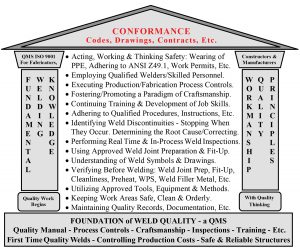
Figure 6. The House of Weld Quality symbolizes philosophies, principles, and actions essential to quality structural welding and fabrication.
Conclusion
Weld defects are not free and come at a burdensome cost. A welder makes weld defects and is being paid for making them, as well as to repair them, and an inspector is being paid to re-inspect for them. Therefore, the importance of comprehensive welder training cannot be overstated. Quality is a business philosophy where the House of Weld Quality exemplifies requisite quality structural welding and fabrication criteria. To achieve quality structural welding and fabrication, a rigorous QMS infrastructure is essential where training, in-process monitoring, process controls, auditing, inspections, and more are aimed at improving production effectiveness and efficiency by preventing, correcting, and eliminating opportunities for errors, deficiencies, and non-conformances that occur throughout fabrication.
What does this mean for you? Understanding how quality can and should be built into a product rather than corrected after the fact can help the practicing engineer better represent the owner, and ultimately, better safeguard the general public. This can be accomplished through development of more quality-focused general notes and specifications, targeting quality in pre-construction meetings, and responding knowledgeably to requests from fabricators or erectors about such quality directives.■
Acronyms
AISI: The American Iron and Steel Institute.
ANSI Z49.1: The America National Standards Institute Z49.1, Safety in Welding, Cutting, And Allied Processes.
ASME: The American Society of Mechanical Engineers.
ASNT: The American Society for Nondestructive Testing.
AWS D1.1: The American Welding Society, Structural Welding Code – Steel.
AWS D1.2: The American Welding Society, Structural Welding Code – Aluminum.
AWS D1.6: The American Welding Society, Structural Welding Code – Stainless Steel.
AWS SCWI, CWI: The American Welding Society, Senior Certified Welding Inspector, Certified Welding Inspector.
GTAW: Gas Tungsten Arc Welding.
NDT: Nondestructive Testing: VT (Visual Testing), RT (Radiographic Testing), MT (Magnetic Particle Testing), UT (Ultrasonic Testing), PT (Liquid Penetrant Testing).
PPE: Personal Protection Equipment.
PQR: Procedure Qualification Record.
PWHT: Post-Weld Heat-Treatment.
QA: Quality Assurance.
WPS: Welding Procedure Specification.
1G: Flat Welding Position.
3G: Vertical Welding Position.

